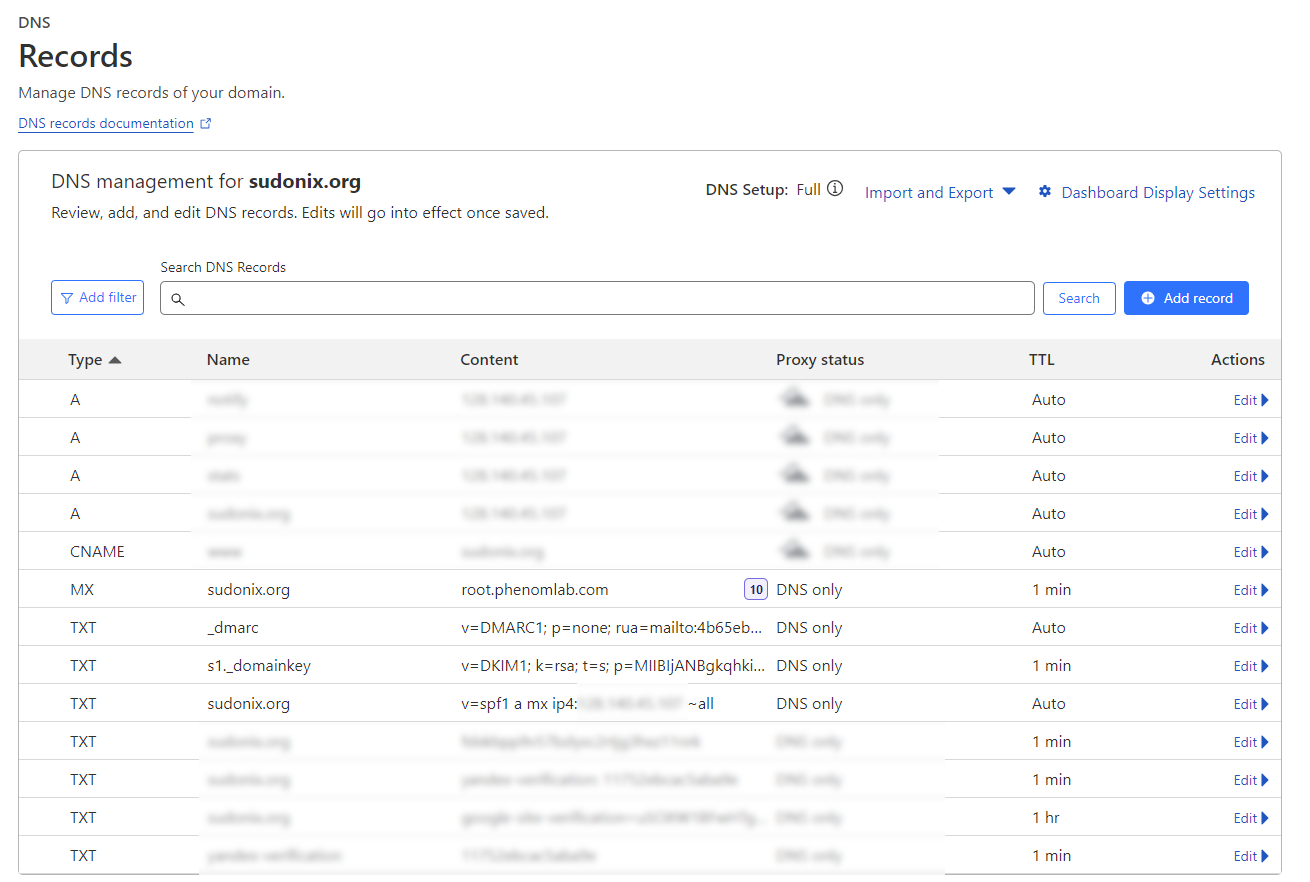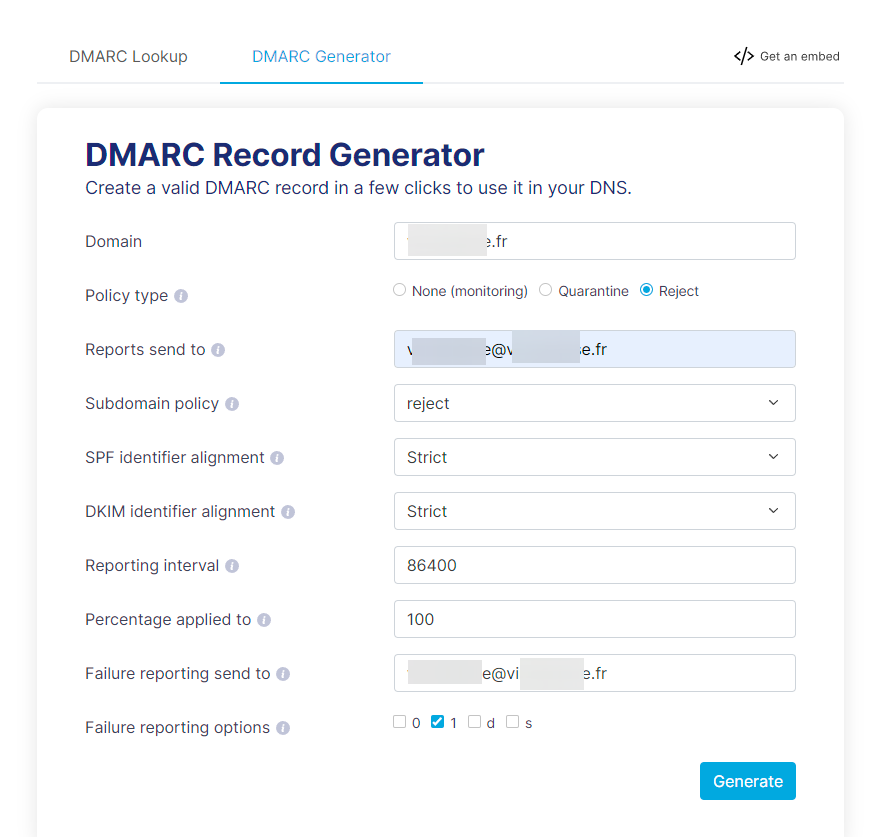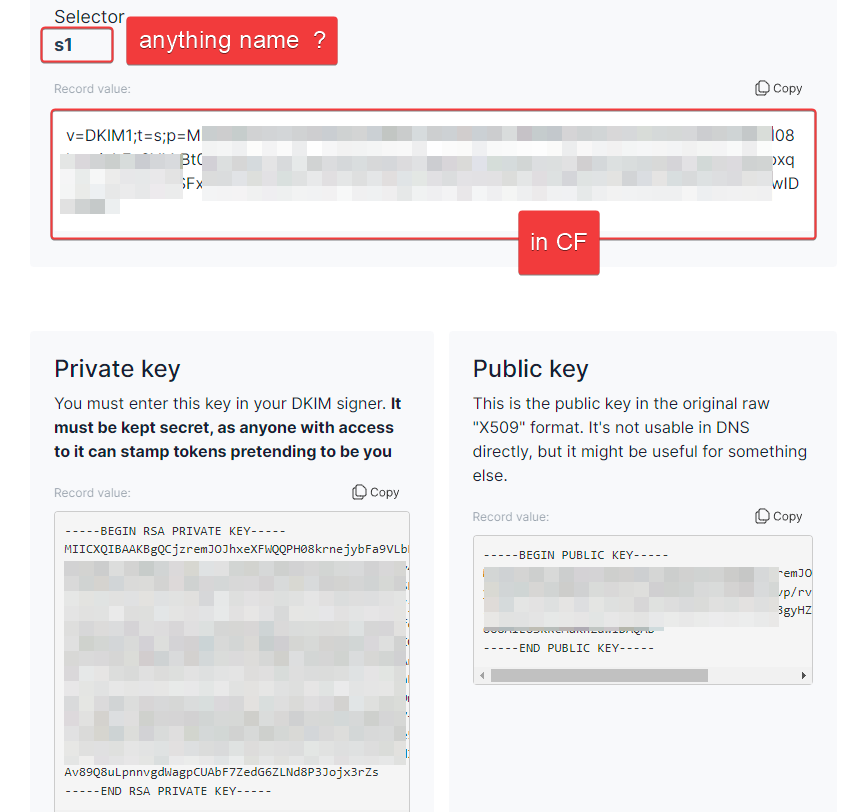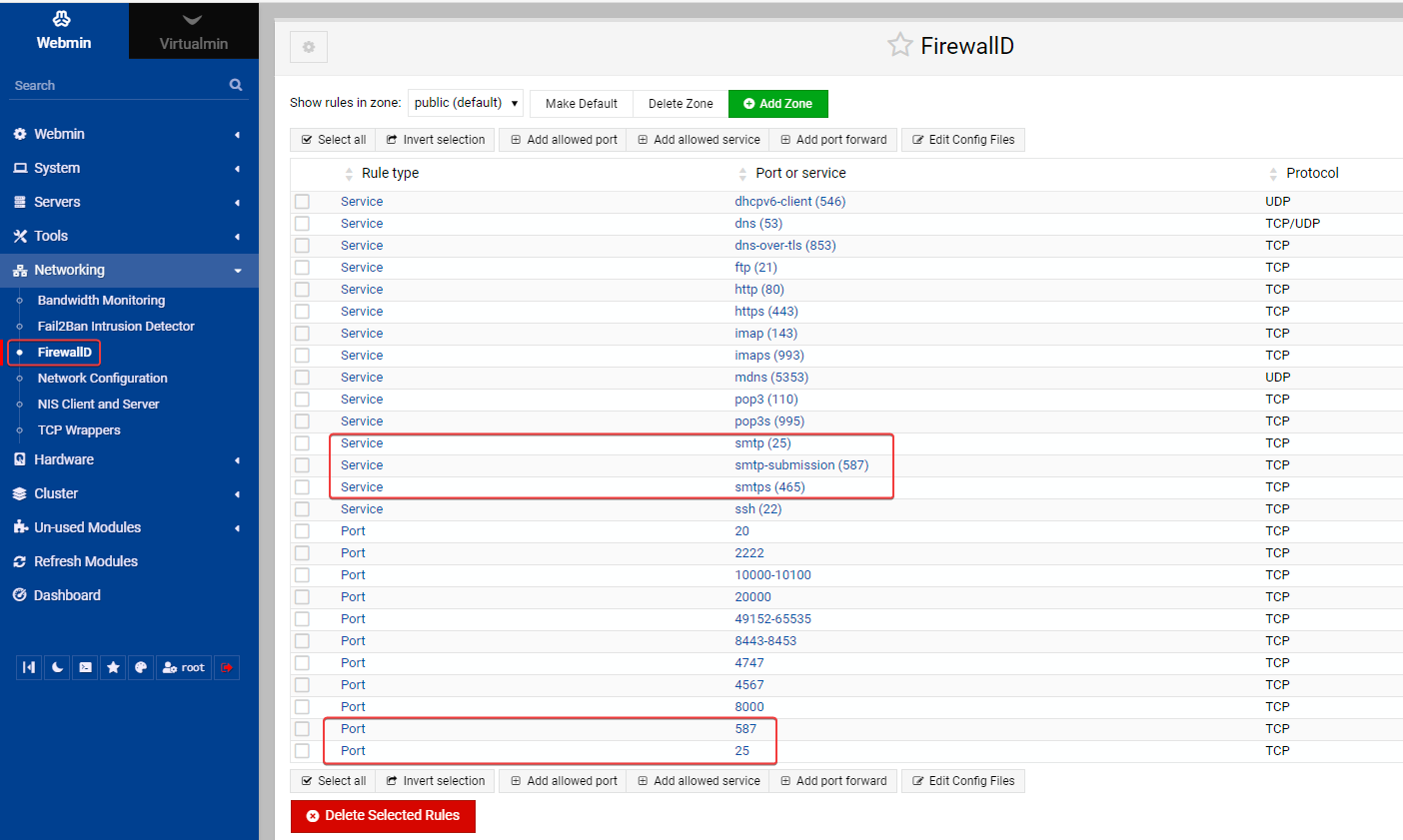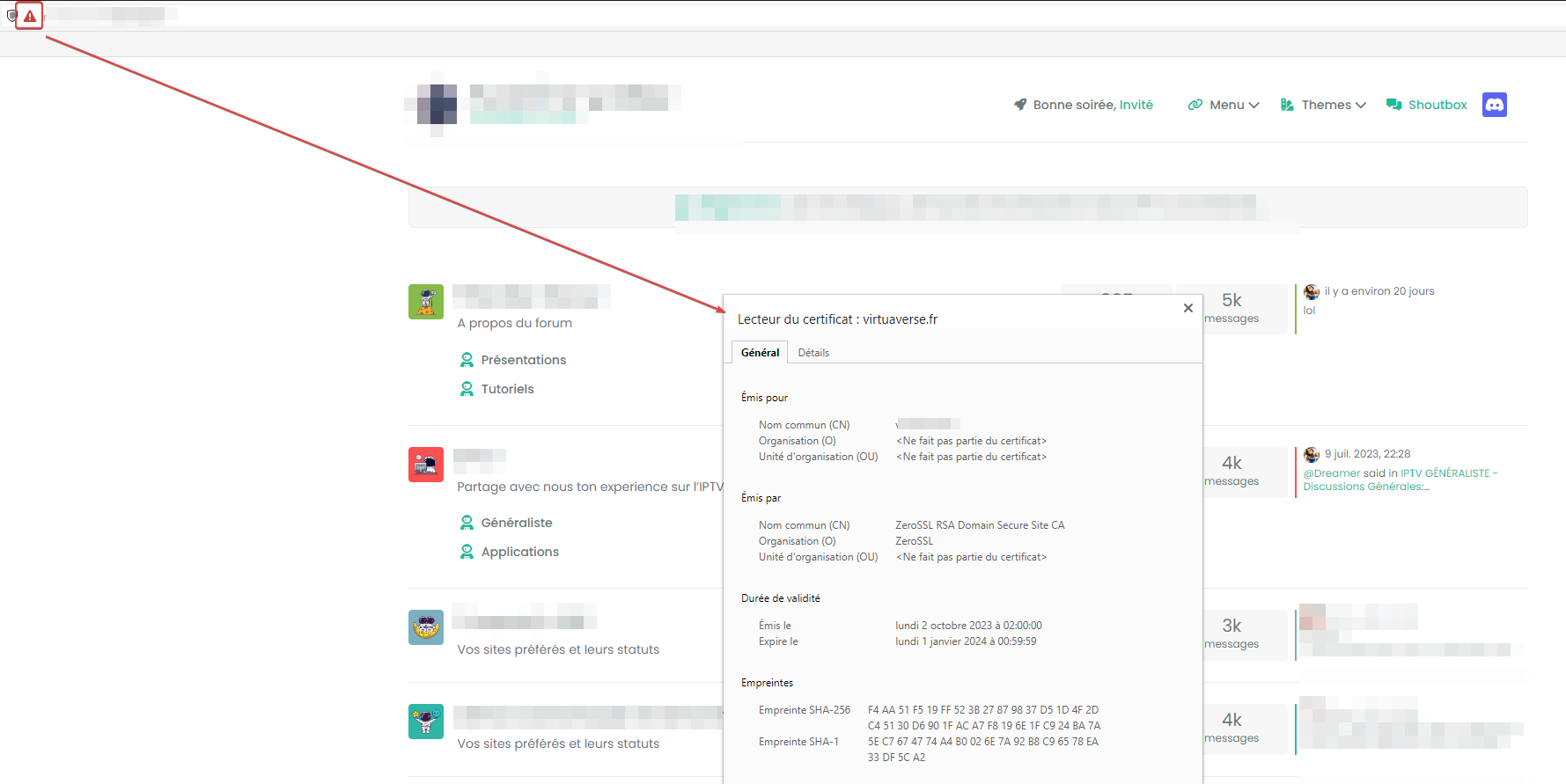Tutorial for secure emailing with personal domain,Cloudflare, virtualmin and postfix
-
Hello Mark,
I’m using and configuring my domain with CloudFlare/virtualmin and would like to be able to use virtualmin and postfix so that applications on my server (like vaultwarden for example) can send emails securely via selhosted SMTP.
Being a little lost in this jungle, could you do a detailed tutorial with screen for :
- DNS/Cloudflare configuration (SPF, MX, DKIM, DMARC)
- Activate email on a virtualmin domain with postfix
- Configure email postfix on virtualmin and postfix
- Configure firewall for emailing (virtualkmin)
- Testing
Thank a lot in advance.
DownPW
-
Hello Mark,
I’m using and configuring my domain with CloudFlare/virtualmin and would like to be able to use virtualmin and postfix so that applications on my server (like vaultwarden for example) can send emails securely via selhosted SMTP.
Being a little lost in this jungle, could you do a detailed tutorial with screen for :
- DNS/Cloudflare configuration (SPF, MX, DKIM, DMARC)
- Activate email on a virtualmin domain with postfix
- Configure email postfix on virtualmin and postfix
- Configure firewall for emailing (virtualkmin)
- Testing
Thank a lot in advance.
DownPW
@DownPW can you clarify the “secure” part? For example, are you looking for postfix to secure the email, or will you handle this via the client?
In addition, under Virtualmin, Postfix is automatically configured per domain and should work without issue.
Can you clarify?
-
a postfix to secure the email.
On the other hand, I have not configured anything on the domain name side. No MX, SPF, dmarc or dkim for example hence the request
@phenomlab said in Tutorial for secure emailing with personal domain,Cloudflare, virtualmin and postfix:
In addition, under Virtualmin, Postfix is automatically configured per domain and should work without issue.
OK so how to test to see if it works correctly ?
For example, the application I want to use requires include this configuration:
SMTP_HOST=xxxx.example.com SMTP_FROM=xxxx@example.com SMTP_FROM_NAME=xxxx SMTP_PORT=587 # Ports 587 (submission) and 25 (smtp) are standard without encryption and with encryption via STARTTLS (Explicit TLS). Port 465 is outdated and us> SMTP_SSL=true # (Explicit) - This variable by default configures Explicit STARTTLS, it will upgrade an insecure connection to a secure one. Unless SMTP_EXPLICIT_> SMTP_EXPLICIT_TLS=false # (Implicit) - N.B. This variable configures Implicit TLS. It's currently mislabelled (see bug #851) - SMTP_SSL needs to be set to true for this o> SMTP_USERNAME=user@example.com SMTP_PASSWORD=mysmtppassword and I look at the postfix config in virtualmin, but I don’t see what values are declared.
And I still have DNS configuration problems at Cloudflare
-
a postfix to secure the email.
On the other hand, I have not configured anything on the domain name side. No MX, SPF, dmarc or dkim for example hence the request
@phenomlab said in Tutorial for secure emailing with personal domain,Cloudflare, virtualmin and postfix:
In addition, under Virtualmin, Postfix is automatically configured per domain and should work without issue.
OK so how to test to see if it works correctly ?
For example, the application I want to use requires include this configuration:
SMTP_HOST=xxxx.example.com SMTP_FROM=xxxx@example.com SMTP_FROM_NAME=xxxx SMTP_PORT=587 # Ports 587 (submission) and 25 (smtp) are standard without encryption and with encryption via STARTTLS (Explicit TLS). Port 465 is outdated and us> SMTP_SSL=true # (Explicit) - This variable by default configures Explicit STARTTLS, it will upgrade an insecure connection to a secure one. Unless SMTP_EXPLICIT_> SMTP_EXPLICIT_TLS=false # (Implicit) - N.B. This variable configures Implicit TLS. It's currently mislabelled (see bug #851) - SMTP_SSL needs to be set to true for this o> SMTP_USERNAME=user@example.com SMTP_PASSWORD=mysmtppasswordand I look at the postfix config in virtualmin, but I don’t see what values are declared.
And I still have DNS configuration problems at Cloudflare
@DownPW said in Tutorial for secure emailing with personal domain,Cloudflare, virtualmin and postfix:
a postfix to secure the email.
Postfix by default will attempt TLS opportunistic knocking - a process that determines which protocols the receiving host will allow and will then perform a handshake which establishes contact based on those protocols (provided both ends support it - which in most cases, they do). Security between connecting domains is typically certificate based, although you require one certificate minimum for each domain you will be connecting to. As you can imagine, this is not really feasible unless you forward all mail to a relay host and secure that channel with a certificate.
However, at that point, you are trusting the relay host to send the email in a secure manner which may not always be the case.
@DownPW said in Tutorial for secure emailing with personal domain,Cloudflare, virtualmin and postfix:
OK so how to test to see if it works correctly ?
By default, each domain created in Virtualmin will have a corresponding email account for each domain. For example
As you can see from this example, there is a mail account added here. By default, Virtualmin based domains have email which is accessible at
https://yourserver.com:20000where you can login to that same portal, and access mail sent and received for that domain.If you wanted to define the below
SMTP_HOST=xxxx.example.com SMTP_FROM=xxxx@example.com SMTP_FROM_NAME=xxxx SMTP_PORT=587 It could look something like the below
SMTP_HOST=vps.mydomain.com # This is the name of the Virtualmin instance itself SMTP_FROM=user@mydomain.com # Change this to the sender email address you want to use SMTP_FROM_NAME=xxxx # Change this to the sender name, for example, "John Smith" SMTP_PORT=587 # Change this to the port number that the server will answer on. Postfix by default will listen on a variety of ports, with 587 being one of them. @DownPW said in Tutorial for secure emailing with personal domain,Cloudflare, virtualmin and postfix:
and I look at the postfix config in virtualmin, but I don’t see what values are declared.
You should not have to modify Postfix in any way unless there is a specific reason to do so.
@DownPW said in Tutorial for secure emailing with personal domain,Cloudflare, virtualmin and postfix:
And I still have DNS configuration problems at Cloudflare
By this, do you mean the absence of
DKIM,DMARCandSPFor other issues? -
@DownPW said in Tutorial for secure emailing with personal domain,Cloudflare, virtualmin and postfix:
a postfix to secure the email.
Postfix by default will attempt TLS opportunistic knocking - a process that determines which protocols the receiving host will allow and will then perform a handshake which establishes contact based on those protocols (provided both ends support it - which in most cases, they do). Security between connecting domains is typically certificate based, although you require one certificate minimum for each domain you will be connecting to. As you can imagine, this is not really feasible unless you forward all mail to a relay host and secure that channel with a certificate.
However, at that point, you are trusting the relay host to send the email in a secure manner which may not always be the case.
@DownPW said in Tutorial for secure emailing with personal domain,Cloudflare, virtualmin and postfix:
OK so how to test to see if it works correctly ?
By default, each domain created in Virtualmin will have a corresponding email account for each domain. For example

As you can see from this example, there is a mail account added here. By default, Virtualmin based domains have email which is accessible at
https://yourserver.com:20000where you can login to that same portal, and access mail sent and received for that domain.If you wanted to define the below
SMTP_HOST=xxxx.example.com SMTP_FROM=xxxx@example.com SMTP_FROM_NAME=xxxx SMTP_PORT=587It could look something like the below
SMTP_HOST=vps.mydomain.com # This is the name of the Virtualmin instance itself SMTP_FROM=user@mydomain.com # Change this to the sender email address you want to use SMTP_FROM_NAME=xxxx # Change this to the sender name, for example, "John Smith" SMTP_PORT=587 # Change this to the port number that the server will answer on. Postfix by default will listen on a variety of ports, with 587 being one of them.@DownPW said in Tutorial for secure emailing with personal domain,Cloudflare, virtualmin and postfix:
and I look at the postfix config in virtualmin, but I don’t see what values are declared.
You should not have to modify Postfix in any way unless there is a specific reason to do so.
@DownPW said in Tutorial for secure emailing with personal domain,Cloudflare, virtualmin and postfix:
And I still have DNS configuration problems at Cloudflare
By this, do you mean the absence of
DKIM,DMARCandSPFor other issues?@phenomlab said in Tutorial for secure emailing with personal domain,Cloudflare, virtualmin and postfix:
By this, do you mean the absence of DKIM, DMARC and SPF or other issues?
yes and MX too
-
@phenomlab said in Tutorial for secure emailing with personal domain,Cloudflare, virtualmin and postfix:
By this, do you mean the absence of DKIM, DMARC and SPF or other issues?
yes and MX too
@DownPW said in Tutorial for secure emailing with personal domain,Cloudflare, virtualmin and postfix:
yes and MX too
Ok. MX is the base requirement for mail to be delivered in any circumstance, and all DNS zone files should have a least one entry. For example:
The MX record
root.phenomlab.comis my VPS server, and yours ideally would be something similar. MX records require a weight based preference to determine order (in my case, 10), and it’s possible to have multiple - for example, 20 would be used to define the next in the list if the primary record is not available.In terms of Cloudflare DNS, an example of this is below
There are a number of quality free tools that can help you create
DMARC,SPF, andDKIMrecords as shown belowDMARC
DIKM
SPF
-
@phenomlab said in Tutorial for secure emailing with personal domain,Cloudflare, virtualmin and postfix:
By default, Virtualmin based domains have email which is accessible at https://yourserver.com:20000
hmmm acess seem to work, I log with root but Inbox doesn’t seem to load correctly.
After a moment I have this message :
If I log with my root account like always, I have this :
EDIT: seems Ok with other account. Seems root account doesn’t have inbox
@phenomlab said in Tutorial for secure emailing with personal domain,Cloudflare, virtualmin and postfix:
The MX record root.phenomlab.com is my VPS server
what is root.phenomlab.com on your virtualmin? it’s not a virtual server, jsut your hostname i guess
For example, I am login to virtualmin on adm.xxxx.fr (hostname of my server) so my mx field should be adm.xxxx.fr and not root.xxxx.fr right?
for dmarc and dkim, i’am not see for the moment, i see later
— EDIT:
my Dmarc configuration
-
DMARC =
v=DMARC1;p=reject;sp=reject;pct=100;rua=mailto:xxxxxxx@xxxxxxx.fr;ruf=mailto:xxxxxxx@xxxxxxx.fr;ri=86400;aspf=s;adkim=s;fo=1;What do you think about it ?
For DKIM, I don’t quite understand. Once generated in the tools you gave, I understand for the DNS entry in CF but what do I do with the private and public key?
-
Ok I have test to send an email with usermin. No error but email but I don’t receive the email
-
Ok I have test to send an email with usermin. No error but email but I don’t receive the email
See this to mail queue :
/var/log/mail.log
Feb 20 21:26:24 adm postfix/smtp[674993]: E1205627B7: to=<xxxxxxxxxx@caramail.com>, relay=none, delay=4339, delays=4279/0.03/60/0, dsn=4.4.1, status=deferred (connect to mx00.caramail.com[212.227.15.30]:25: Connection timed out) Feb 20 21:26:24 adm postfix/smtp[674993]: connect to mx00.caramail.com[212.227.15.30]:25: Connection timed out Very strange. I’ll stop there for tonight.
-
Ok I have test to send an email with usermin. No error but email but I don’t receive the email
See this to mail queue :

/var/log/mail.log
Feb 20 21:26:24 adm postfix/smtp[674993]: E1205627B7: to=<xxxxxxxxxx@caramail.com>, relay=none, delay=4339, delays=4279/0.03/60/0, dsn=4.4.1, status=deferred (connect to mx00.caramail.com[212.227.15.30]:25: Connection timed out) Feb 20 21:26:24 adm postfix/smtp[674993]: connect to mx00.caramail.com[212.227.15.30]:25: Connection timed outVery strange. I’ll stop there for tonight.
@DownPW that looks like the port (25) is unreachable. Have you configured the firewall in your Virtualmin server to permit this outbound traffic? Similarly, do you have any other firewall type device between the server and the Internet which could be dropping packets?
-
no Hetzner firewall configured
no crowdsecI have just firewalld of virtualmin by default. I have add 25 and 587 port. Same problem
other log :
Feb 20 21:40:11 adm postfix/smtpd[679903]: disconnect from unknown[45.129.14.179] ehlo=1 auth=0/1 rset=1 quit=1 commands=3/4 Feb 20 21:40:11 adm postfix/smtpd[679903]: warning: unknown[45.129.14.179]: SASL LOGIN authentication failed: authentication failure Feb 20 21:40:05 adm postfix/smtpd[679903]: connect from unknown[45.129.14.179] Feb 20 21:40:05 adm postfix/smtpd[679903]: warning: hostname 179.hosted-by.198xd.com does not resolve to address 45.129.14.179 Feb 20 21:39:54 adm postfix/smtpd[679911]: disconnect from unknown[45.129.14.179] ehlo=1 auth=0/1 rset=1 quit=1 commands=3/4 Feb 20 21:39:54 adm postfix/smtpd[679911]: warning: unknown[45.129.14.179]: SASL LOGIN authentication failed: authentication failure Feb 20 21:39:50 adm postfix/smtpd[679903]: disconnect from unknown[45.129.14.128] ehlo=1 auth=0/1 rset=1 quit=1 commands=3/4 Feb 20 21:39:50 adm postfix/smtpd[679903]: warning: unknown[45.129.14.128]: SASL LOGIN authentication failed: authentication failure Feb 20 21:39:47 adm postfix/smtpd[679911]: connect from unknown[45.129.14.179] Feb 20 21:39:47 adm postfix/smtpd[679911]: warning: hostname 179.hosted-by.198xd.com does not resolve to address 45.129.14.179 Feb 20 21:39:39 adm postfix/smtpd[679903]: connect from unknown[45.129.14.128] Feb 20 21:39:39 adm postfix/smtpd[679903]: warning: hostname 128.hosted-by.198xd.com does not resolve to address 45.129.14.128 Feb 20 21:39:38 adm postfix/smtpd[679911]: disconnect from unknown[45.129.14.179] ehlo=1 auth=0/1 rset=1 quit=1 commands=3/4 Feb 20 21:39:37 adm postfix/smtpd[679911]: warning: unknown[45.129.14.179]: SASL LOGIN authentication failed: authentication failure Feb 20 21:39:32 adm postfix/smtpd[679903]: disconnect from unknown[45.129.14.128] ehlo=1 auth=0/1 rset=1 quit=1 commands=3/4 Feb 20 21:39:32 adm postfix/smtpd[679903]: warning: unknown[45.129.14.128]: SASL LOGIN authentication failed: authentication failure Feb 20 21:39:30 adm postfix/smtpd[679911]: connect from unknown[45.129.14.179] Feb 20 21:39:30 adm postfix/smtpd[679911]: warning: hostname 179.hosted-by.198xd.com does not resolve to address 45.129.14.179 Feb 20 21:39:24 adm postfix/smtpd[679903]: connect from unknown[45.129.14.128] Feb 20 21:39:24 adm postfix/smtpd[679903]: warning: hostname 128.hosted-by.198xd.com does not resolve to address 45.129.14.128 Feb 20 21:39:22 adm postfix/smtp[679066]: 1AD316278E: to=<xxxxxxxxxxxx@gmail.com>, relay=none, delay=3410, delays=3260/0.03/150/0, dsn=4.4.1, status=deferred (connect to alt2.gmail-smtp-in.l.google.com[2a00:1450:4025:c03::1a]:25: Connection timed out) Feb 20 21:39:22 adm postfix/smtp[679066]: connect to alt2.gmail-smtp-in.l.google.com[2a00:1450:4025:c03::1a]:25: Connection timed out Feb 20 21:39:19 adm postfix/smtpd[679911]: disconnect from unknown[45.129.14.179] ehlo=1 auth=0/1 rset=1 quit=1 commands=3/4 Feb 20 21:39:19 adm postfix/smtpd[679911]: warning: unknown[45.129.14.179]: SASL LOGIN authentication failed: authentication failure Feb 20 21:39:17 adm postfix/smtpd[679903]: disconnect from unknown[45.129.14.128] ehlo=1 auth=0/1 rset=1 quit=1 commands=3/4 Feb 20 21:39:16 adm postfix/smtpd[679903]: warning: unknown[45.129.14.128]: SASL LOGIN authentication failed: authentication failure Feb 20 21:39:12 adm postfix/smtpd[679911]: connect from unknown[45.129.14.179] Feb 20 21:39:12 adm postfix/smtpd[679911]: warning: hostname 179.hosted-by.198xd.com does not resolve to address 45.129.14.179 Feb 20 21:39:08 adm postfix/smtpd[679903]: connect from unknown[45.129.14.128] Feb 20 21:39:08 adm postfix/smtpd[679903]: warning: hostname 128.hosted-by.198xd.com does not resolve to address 45.129.14.128 Feb 20 21:39:02 adm postfix/smtpd[679911]: disconnect from unknown[45.129.14.179] ehlo=1 auth=0/1 rset=1 quit=1 commands=3/4 Feb 20 21:39:01 adm postfix/smtpd[679911]: warning: unknown[45.129.14.179]: SASL LOGIN authentication failed: authentication failure Feb 20 21:39:01 adm postfix/smtpd[679903]: disconnect from unknown[45.129.14.128] ehlo=1 auth=0/1 rset=1 quit=1 commands=3/4 Feb 20 21:39:00 adm postfix/smtpd[679903]: warning: unknown[45.129.14.128]: SASL LOGIN authentication failed: authentication failure Feb 20 21:38:55 adm postfix/smtpd[679911]: connect from unknown[45.129.14.179] Feb 20 21:38:55 adm postfix/smtpd[679911]: warning: hostname 179.hosted-by.198xd.com does not resolve to address 45.129.14.179 Feb 20 21:38:53 adm postfix/smtpd[679903]: connect from unknown[45.129.14.128] Feb 20 21:38:53 adm postfix/smtpd[679903]: warning: hostname 128.hosted-by.198xd.com does not resolve to address 45.129.14.128 Feb 20 21:38:52 adm postfix/smtp[679066]: connect to alt1.gmail-smtp-in.l.google.com[2a00:1450:4013:c16::1b]:25: Connection timed out Feb 20 21:38:44 adm postfix/smtpd[679903]: disconnect from unknown[45.129.14.128] ehlo=1 auth=0/1 rset=1 quit=1 commands=3/4 Feb 20 21:38:43 adm postfix/smtpd[679903]: warning: unknown[45.129.14.128]: SASL LOGIN authentication failed: authentication failure Feb 20 21:38:38 adm postfix/smtpd[679903]: connect from unknown[45.129.14.128] Feb 20 21:38:38 adm postfix/smtpd[679903]: warning: hostname 128.hosted-by.198xd.com does not resolve to address 45.129.14.128 Feb 20 21:38:22 adm postfix/smtp[678126]: 73987627BE: to=<xxxxxxxxxxxxxxxxxxxxxxxx@gmail.com>, relay=none, delay=3350, delays=3200/0.03/150/0, dsn=4.4.1, status=deferred (connect to alt2.gmail-smtp-in.l.google.com[2a00:1450:4025:c03::1a]:25: Connection timed out) Feb 20 21:38:22 adm postfix/smtp[678126]: connect to alt2.gmail-smtp-in.l.google.com[2a00:1450:4025:c03::1a]:25: Connection timed out Feb 20 21:38:22 adm postfix/smtp[679066]: connect to alt1.gmail-smtp-in.l.google.com[142.250.153.26]:25: Connection timed out Feb 20 21:37:52 adm postfix/smtp[678126]: connect to alt1.gmail-smtp-in.l.google.com[2a00:1450:4013:c16::1b]:25: Connection timed out Feb 20 21:37:52 adm postfix/error[679677]: 20D20627C1: to=<xxxxxxxxxxxxxxx@caramail.com>, relay=none, delay=5027, delays=4967/60/0/0.01, dsn=4.4.1, status=deferred (delivery temporarily suspended: connect to mx01.caramail.com[217.72.192.76]:25: Connection timed out) Feb 20 21:37:52 adm postfix/error[679676]: 225BB627B7: to=<xxxxxxxxxxxxxxxxx@caramail.com>, relay=none, delay=3784, delays=3724/60/0/0, dsn=4.4.1, status=deferred (delivery temporarily suspended: connect to mx01.caramail.com[217.72.192.76]:25: Connection timed out) Feb 20 21:37:52 adm postfix/smtp[679070]: 1ED2A627AB: to=<xxxxxxxxxxxxxxxx@caramail.com>, relay=none, delay=4432, delays=4372/0.08/60/0, dsn=4.4.1, status=deferred (connect to mx00.caramail.com[212.227.15.30]:25: Connection timed out) Feb 20 21:37:52 adm postfix/smtp[679070]: connect to mx00.caramail.com[212.227.15.30]:25: Connection timed out Feb 20 21:37:52 adm postfix/error[679676]: 1FBDB627B3: to=<xxxxxxxxxxxxxxxx@caramail.com>, relay=none, delay=3500, delays=3440/60/0/0.01, dsn=4.4.1, status=deferred (delivery temporarily suspended: connect to mx01.caramail.com[217.72.192.76]:25: Connection timed out) Feb 20 21:37:52 adm postfix/smtp[679069]: 1DE7B62796: to=<xxxxxxxxxxxxxx@caramail.com>, relay=none, delay=4587, delays=4527/0.07/60/0, dsn=4.4.1, status=deferred (connect to mx01.caramail.com[217.72.192.76]:25: Connection timed out) Feb 20 21:37:52 adm postfix/smtp[679068]: 1D536627AE: to=<xxxxxxxxxxxxxxxx@caramail.com>, relay=none, delay=4531, delays=4471/0.05/60/0, dsn=4.4.1, status=deferred (connect to mx01.caramail.com[217.72.192.76]:25: Connection timed out) Feb 20 21:37:52 adm postfix/smtp[679067]: 1C5D3627B6: to=<xxxxxxxxxxxxxxxxxxx@caramail.com>, relay=none, delay=3815, delays=3755/0.04/60/0, dsn=4.4.1, status=deferred (connect to mx00.caramail.com[212.227.15.30]:25: Connection timed out) Feb 20 21:37:52 adm postfix/smtp[679069]: connect to mx01.caramail.com[217.72.192.76]:25: Connection timed out Feb 20 21:37:52 adm postfix/smtp[679068]: connect to mx01.caramail.com[217.72.192.76]:25: Connection timed out Feb 20 21:37:52 adm postfix/smtp[679067]: connect to mx00.caramail.com[212.227.15.30]:25: Connection timed out Feb 20 21:37:52 adm postfix/smtp[679066]: connect to gmail-smtp-in.l.google.com[142.250.110.27]:25: Connection timed out Feb 20 21:37:22 adm postfix/smtp[678126]: connect to alt1.gmail-smtp-in.l.google.com[142.250.153.26]:25: Connection timed out Feb 20 21:37:22 adm postfix/smtp[679070]: connect to mx01.caramail.com[217.72.192.76]:25: Connection timed out Feb 20 21:37:22 adm postfix/smtp[679069]: connect to mx00.caramail.com[212.227.15.30]:25: Connection timed out Feb 20 21:37:22 adm postfix/smtp[679068]: connect to mx00.caramail.com[212.227.15.30]:25: Connection timed out Feb 20 21:37:22 adm postfix/smtp[679067]: connect to mx01.caramail.com[217.72.192.76]:25: Connection timed out Feb 20 21:37:22 adm postfix/smtp[679066]: connect to gmail-smtp-in.l.google.com[2a00:1450:400c:c0b::1b]:25: Connection timed out Feb 20 21:37:05 adm postfix/anvil[677271]: statistics: max cache size 3 at Feb 20 21:27:30 Feb 20 21:37:05 adm postfix/anvil[677271]: statistics: max connection count 1 for (smtp:45.88.90.174) at Feb 20 21:27:05 Feb 20 21:37:05 adm postfix/anvil[677271]: statistics: max connection rate 4/60s for (smtp:45.129.14.128) at Feb 20 21:28:06 Feb 20 21:36:52 adm postfix/smtp[678126]: connect to gmail-smtp-in.l.google.com[142.250.110.27]:25: Connection timed out -
-
@phenomlab said in Tutorial for secure emailing with personal domain,Cloudflare, virtualmin and postfix:
By default, Virtualmin based domains have email which is accessible at https://yourserver.com:20000
hmmm acess seem to work, I log with root but Inbox doesn’t seem to load correctly.
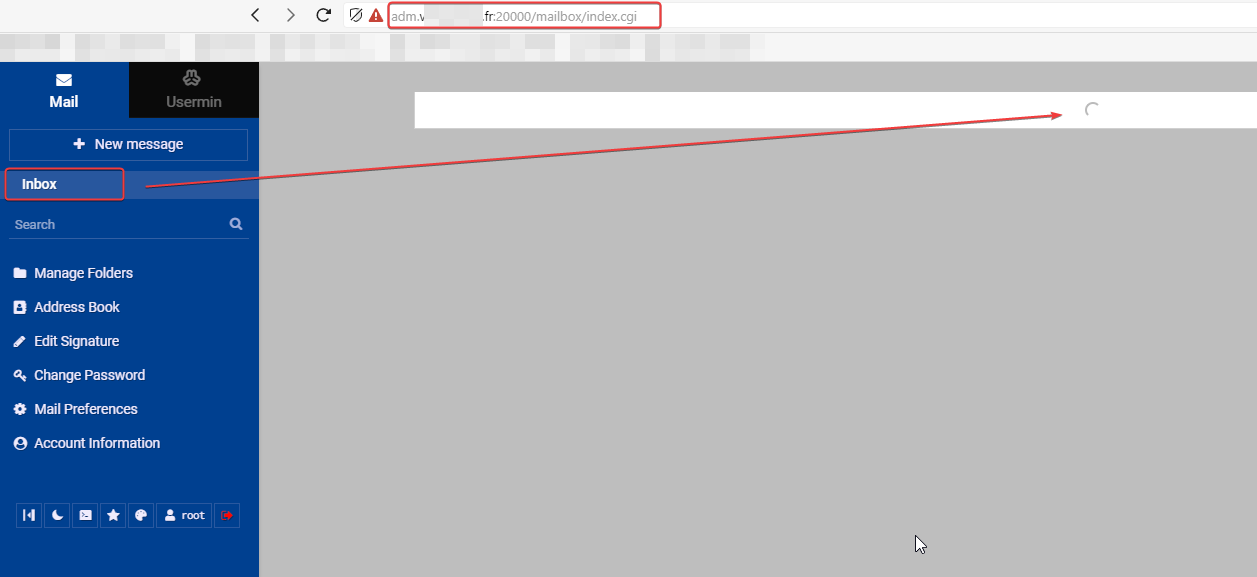
After a moment I have this message :

If I log with my root account like always, I have this :
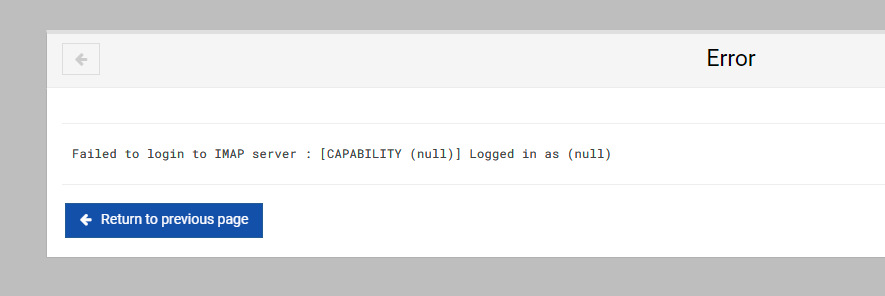
EDIT: seems Ok with other account. Seems root account doesn’t have inbox
@phenomlab said in Tutorial for secure emailing with personal domain,Cloudflare, virtualmin and postfix:
The MX record root.phenomlab.com is my VPS server
what is root.phenomlab.com on your virtualmin? it’s not a virtual server, jsut your hostname i guess
For example, I am login to virtualmin on adm.xxxx.fr (hostname of my server) so my mx field should be adm.xxxx.fr and not root.xxxx.fr right?
for dmarc and dkim, i’am not see for the moment, i see later
— EDIT:
my Dmarc configuration
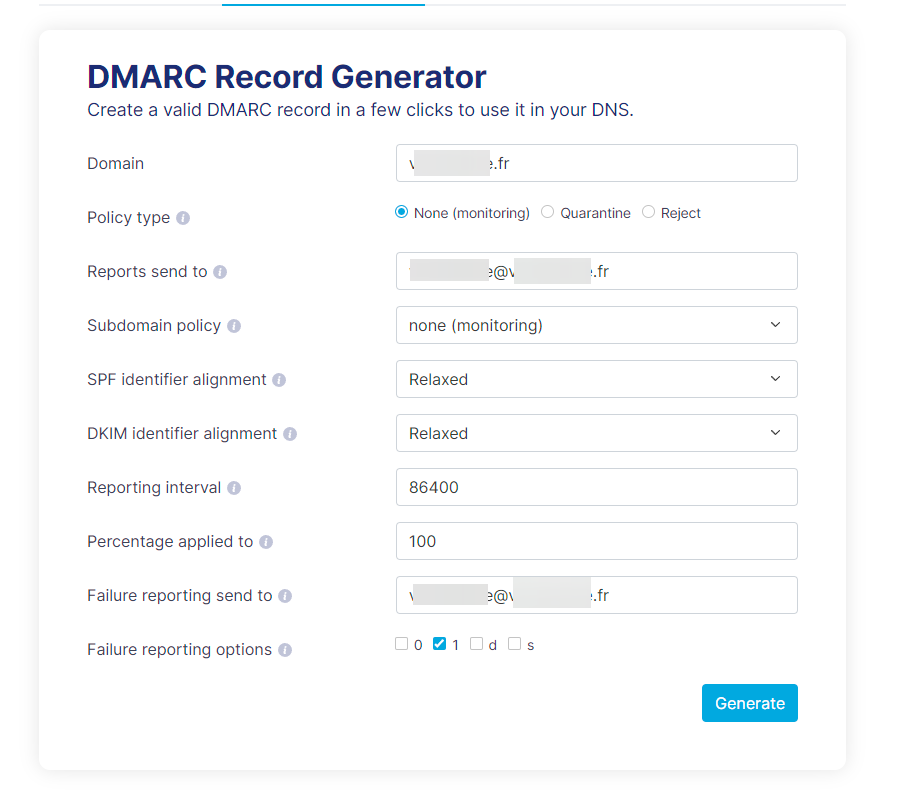
@DownPW said in Tutorial for secure emailing with personal domain,Cloudflare, virtualmin and postfix:
For example, I am login to virtualmin on adm.xxxx.fr (hostname of my server) so my mx field should be adm.xxxx.fr and not root.xxxx.fr right?
Yes, correct.
@DownPW said in Tutorial for secure emailing with personal domain,Cloudflare, virtualmin and postfix:
For DKIM, I don’t quite understand. Once generated in the tools you gave, I understand for the DNS entry in CF but what do I do with the private and public key?
The private and public key can simply be stored. You do not have to do anything with these.
-
@DownPW said in Tutorial for secure emailing with personal domain,Cloudflare, virtualmin and postfix:
Seems port 25 OK
Not sure about that - see below from your server. When sending a
telnetrequest on port 25, there is no response. This typically means the port is closed on your side.What SHOULD happen is this
However, it DOES respond on port 587
From recollection, your VPS is being hosted by Hetzner. Although you have no firewall rules in place to prevent outbound connections on port 25, Hetzner by default will block this port until you’ve paid at least one month’s billing, and will only release the block if you formally request it. You’ll need to get the port unblocked before you can proceed - see below
Unfortunately, email spammers and scammers like to use cloud hosting providers. And we at Hetzner naturally want to prevent this. That’s why we block ports 25 and 465 by default on all cloud servers. This is a very common practice in the cloud hosting industry because it prevents abuse. We want to build trust with our new customers before we unblock these mail ports. Once you have been with us for a month and paid your first invoice, you can create a limit request to unblock these ports for a valid use case. In your request, you can tell us details about your use case. We make decisions on a case-by-case basis.
As an alternative, you can also use port 587 to send emails via external mail delivery services. Port 587 is not blocked and can be used without sending a limit request.
-
OUPS

Ok so I think it’s Hetzner who is blocking.
I will make them an unblocking request. -
OUPS

Ok so I think it’s Hetzner who is blocking.
I will make them an unblocking request.@DownPW Yep

-
-
Indeed. +1 for telnet.
I just trusted the netstats which told me that everything is OK which is certainly the case on the server.
since I didn’t have Telnet on hand I tested a website which told me OK

@DownPW said in Tutorial for secure emailing with personal domain,Cloudflare, virtualmin and postfix:
since I didn’t have Telnet on hand I tested a website which told me OK
I have to confess, I installed the
telnet-clienton your server for diagnostic purposes. -
OUPS

Ok so I think it’s Hetzner who is blocking.
I will make them an unblocking request.@DownPW said in Tutorial for secure emailing with personal domain,Cloudflare, virtualmin and postfix:
I will make them an unblocking request.
Curious to know how you got on with this…
Hello! It looks like you're interested in this conversation, but you don't have an account yet.
Getting fed up of having to scroll through the same posts each visit? When you register for an account, you'll always come back to exactly where you were before, and choose to be notified of new replies (ether email, or push notification). You'll also be able to save bookmarks, use reactions, and upvote to show your appreciation to other community members.
With your input, this post could be even better 💗
RegisterLog in

